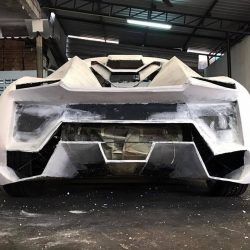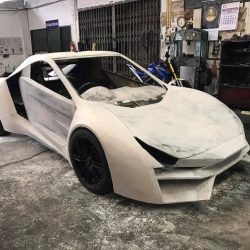What lies behind his barbecue parlor buffet is an urprecendented vehicle that will soon strike the streets
Since the first prototype of his electric car was exhibited at Creative Thailand 2016 around the end of last year, the name Weerasak Panpueng has been widely recognized by the media. The vehicle (which he named Scorpion EV) has been showcased in several other events and appeared in a great number of TV shows where Panpueng was invited to speak about his invention. We were first introduced to him at a FAB Meetup held at FabCafe Bangkok in February 2017. In our memory, his lecture impressed both the ‘geeks’ and startups from Thailand and other countries who were participating in the event a great deal. The majority of the audience was quite fascinated by Panpueng’s practical development and experimentation that is brilliantly simple and straightforward. The most mesmerizing thing about his lecture that day was the fact that the creation of the electrical car began as Panpueng’s hobby, but a hobby that he was truly passionate about. Listening to his story and how he spent every morning putting together the prototype, we began to think about the extent of this dedication and determination that the owner of a barbecue parlor in Lamphun put into the making of the Scorpion EV, and we were left feeling nothing but impressed.
It’s now been months since the event and we were curious about the progress of the project’s development. Judging from his new workshop, which is a large warehouse near Pattaya’s famous Four-Region Floating Market, we thought his life must have changed quite a great deal from how it was several months ago. art4d met with Panpueng at his Pattaya workshop to talk about life, childhood interests and his role today as a full time electric vehicle inventor.
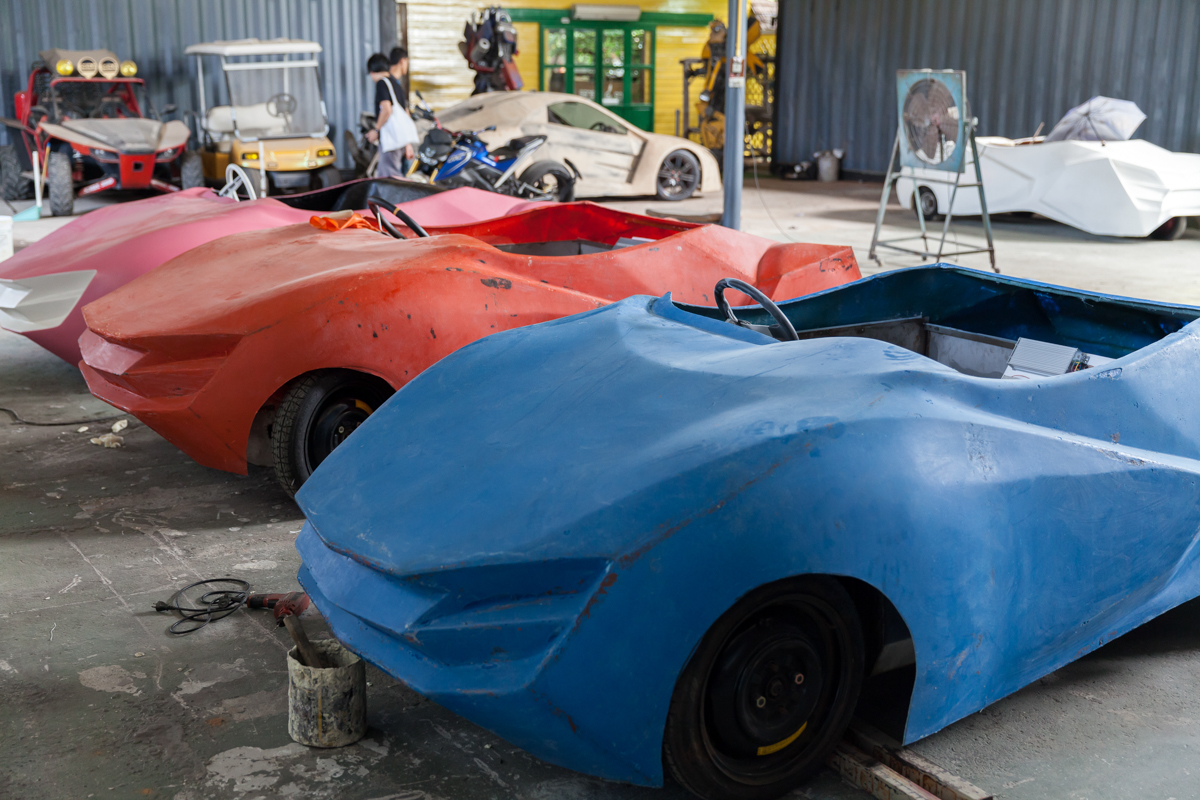
“When I was in fifth or sixth grade, I bought an automobile motor and turned an old bicycle into an electric one. I liked the electric motor because it made less noise. Most petrol engines are so loud and the smell of gasoline is very bad so I’ve always, since I was a child, been interested in electric motors. My family ran an auto shop in Suphan Buri so I played with old motors, windshield wipers, side view mirrors and starters. These were my toys. I would disassemble the things entirely and play around with them.” Panpueng continued to share his life story, telling us about the time when he had to quit school in just the sixth grade to help out the family’s business. He continued to pursue a non-formal education curriculum and was finally able to finish high school. Panpueng then went on to study and gained a vocational diploma in electrical power. During his teenage years, he traveled back and forth between Suphan Buri and Chai Nat due to the relocation of his father’s business.
“After I turned 20 and got my diploma, I lived the life of a nomad. I began working as a construction worker, knowing nothing, having zero skills. Hua Hin was the first site, then I moved on to other projects in Phuket, Chiang Rai and several other provinces. I started to become a sub-contractor before I moved on to have 300 workers working for me. It got so big that I thought I couldn’t handle the responsibility because I was very young considering the number of people I had to supervise, so I decided to quit the business. And there is the financial risk that comes with the business when you’re a sub-contractor, so that was also a factor.”
During his contractor years, Panpueng rekindled his passion for electric vehicles and childhood interest in electric engines. After work or in his free time, he enjoyed self taught lessons and started to order parts and tools from alibaba.com. He again disassembled and studied the mechanism with Google and YouTube being his sources of knowledge. Not knowing English, he used Google translate to help with the translation from Thai to English. The English terms were further searched and the information translated back to Thai before being applied to the actual experiments. Some succeeded, some failed, as one would expect, but Panpueng’s knowledge accumulated by the day.
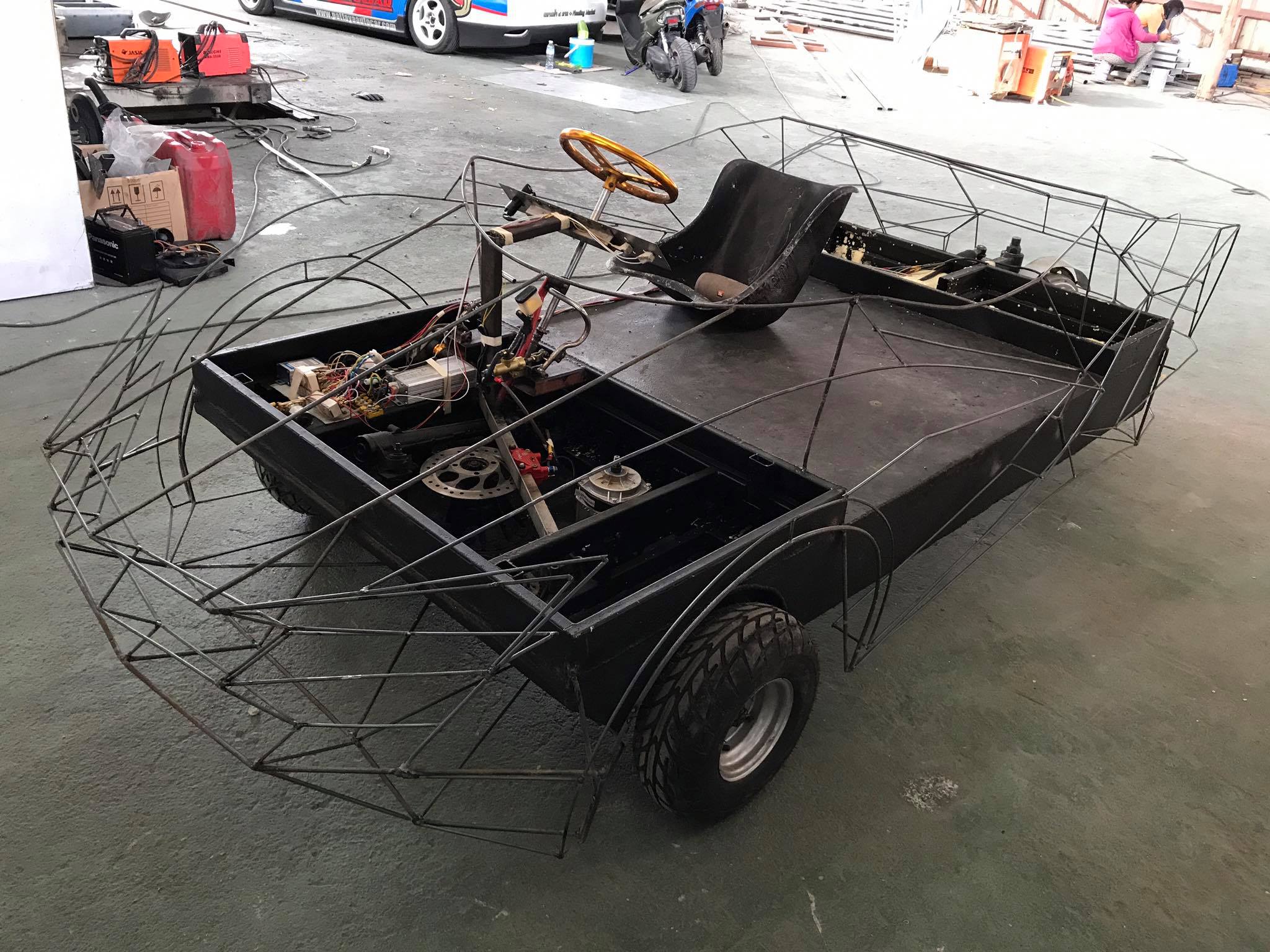
“I quit the contracting business with a sum of money so I decided to move to Lamphun because my uncle lives there. My house in Suphan Buri was close to Mitr Phol’s sugar factory and an ethanol fuel plant so the air was getting polluted. My old man was growing older so we thought it might be better to move to Lamphun because the environment is better, with orchards, mountains, waterfalls and creeks not to mention longan, so the whole family relocated.”
It is in Lamphun that his electric vehicle project became more substantial along with his barbecue buffet parlor business. “I got up at 6 in the morning and went straight to the car. I worked on it until around 8 and then I would leave for the market to buy stuff for the restaurant. I came back around noon and prepared everything until 3-4 p.m. and the restaurant would run until 10 p.m. or midnight. We would close up and go to bed,” Panpueng told us of his daily routine. “That was my life for months until the progress of my electric car project became more tangible.”
While his electric vehicle garnered recognition from countless exhibitions in Bangkok, his barbecue buffet business didn’t go well. “I charged my customer 169 THB per person but what they actually ate cost me around 300. I couldn’t charge them a higher amount because then it would be too expensive and I used pretty high quality ingredients that could easily demand 499 THB per head if the restaurant were in Bangkok. It’s almost like I gave away free food and practically all the money was gone within three months. The business costed me 10,000-20,000 THB a day and there wasn’t any profit from it. I fought because I thought that if the place became more popular and we could have more customers we would start to make some profit but in reality it wasn’t like that. I lost almost all of the money I invested so I thought that I should just close it down. It just happened that a senior of mine saw the car so he asked me to work with him at an electric vehicle manufacturing company in Bangkok. He offered me a salary and 10% of the shares if the company expanded as well as profitsharing.” With the new job offer, Panpueng left the barbeque buffet business behind and began his new path as a full-time electric vehicle inventor in the capital city.
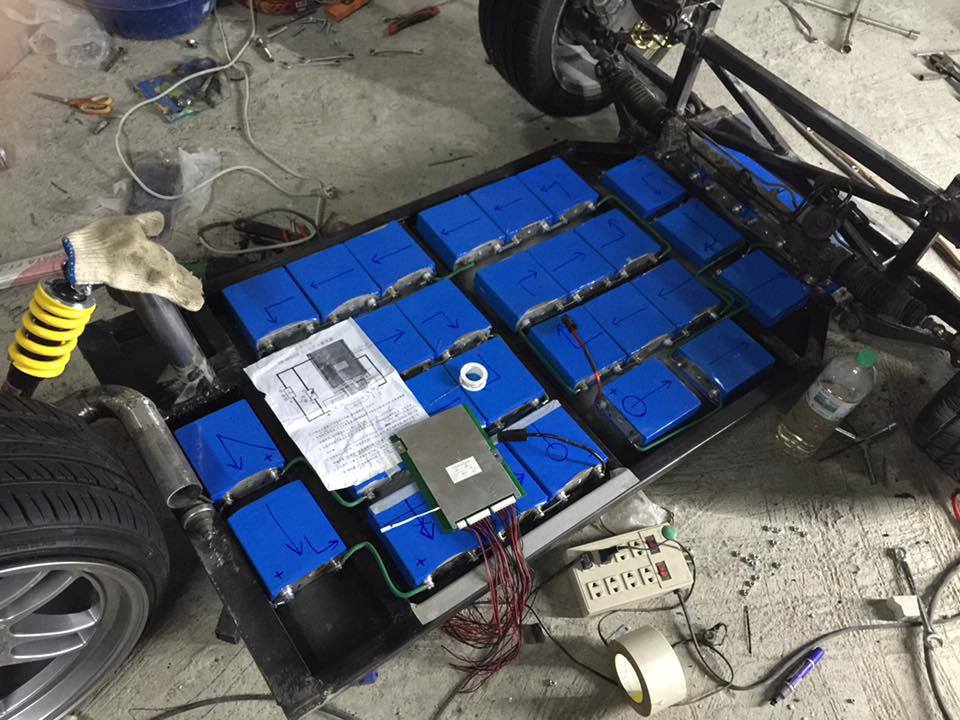
Photo Courtesy of Weerasak Panpueng
“For the new model (with Scorpion mutation being the given name), the goal was for it to be used in real life so the size was larger. We wanted it to reach the acceleration ability of 90-130 kph and a 300 kilometer distance on one charge, which is moderate for normal everyday use that isn’t a cross-province trip. If this were to be successful, the next plan would be finding a way to maintain the same distance using the same battery power. It’s about maximizing the efficiency of power usage by minimizing the power output in order to extend the duration of usage per one charge. We incorporated a hybrid technique into the brake system so that the power could be charged either when you brake or via conversion of the wind power or heat that the car is exposed to when it’s moving into electric power.”
But the new project lasted about two months before the company closed down. Panpueng used Facebook to promote his project and raised funds to complete the development. It got the attention of Manas Meephong, the Chairman of Pattaya’s Four-Region Floating Market. Meephong’s interest in the project led him to invite Panpueng and his family to relocate to the Market where they were offered a place to stay and a space where they could start a restaurant business. The Chairman offered to invest in the development, and if the project were to be successful, Meephong would be able to make money from the profit.
“When I work, I never sketch. I think about what I’m going to do and I do it. I try both the right and wrong but I can’t create a clay model and work from there, which is what most people do. I’m not too much of an artsy guy,” explained Panpueng about his own working process. “First of all, I think about the design that I want for the car and then I begin by constructing the actual structure, starting from the bottom, then moving on to the body.” We asked Panpueng about his next goals for the development of the electric vehicle. “I want to find a way to create an electric vehicle that requires no charging of the battery throughout its lifetime. The goal is for a single charge to last for five years. After five years, the battery can be changed and used again so users don’t have to charge the battery by themselves. They don’t have to worry about when and where they can charge the battery or stuff like that. The idea is to minimize power usage or find a way for the battery’s power to be recycled, or perhaps develop a system that allows for the battery to be charged while the car is parked.”
หลังจากที่รถยนต์ไฟฟ้าต้นแบบที่สร้างขึ้นมาคันแรกถูกนำไปจัดแสดงที่งาน Creative Thailand 2016 เมื่อปลายปีที่ผ่านมา ก็ทำให้ชื่อของ วีระศักดิ์ แป้นพ่วง เริ่มเป็นที่รู้จักผ่านสื่อ มีการเดินสายนำรถคันที่ว่านี้ (เขาตั้งชื่อให้มันว่า Scorpion EV) ไปจัดแสดงตามที่ต่างๆ อีกหลายครั้ง รวมถึงไปออกทีวีเพื่อให้สัมภาษณ์อีกหลายรายการ เรารู้จักเขาเป็นครั้งแรกตอนที่ไปร่วมงาน FAB Meetup ที่ FabCafe Bangkok ในช่วงเดือนกุมภาพันธ์ที่ผ่านมา เท่าที่จำได้การบรรยายของเขาในวันนั้นสร้างความประทับใจแก่ ‘geek’ และ startup ทั้งไทยและต่างประเทศที่มาร่วมงานไม่น้อย ความคิดเห็นโดยรวมของผู้ชมคือค่อนข้างทึ่งกับการพัฒนา ปรับปรุง และลองผิดลองถูกที่ practical ของวีระศักดิ์ ในขณะเดียวกันก็ดูง่ายๆ บ้านๆ แบบตรงไปตรงมา และสำหรับเรา สิ่งที่ทำให้รู้สึกน่าทึ่งในวันนั้นก็คือ นี่เป็นการสร้างรถยนต์ไฟฟ้าที่มีลักษณะเหมือนเป็นงานอดิเรกที่ดูจริงจังและมุ่งมั่นจนน่าประทับใจ ซึ่งทำโดยเจ้าของร้านหมูกระทะในจังหวัดลำพูน ที่ใช้เวลาในช่วงเช้าของแต่ละวันสร้างสรรค์รถคันนี้ขึ้นมา
จากวันนั้นก็ผ่านมาหลายเดือนแล้ว เราก็อยากรู้ว่าการพัฒนารถยนต์ไฟฟ้าของวีระศักดิ์ได้คืบหน้าไปขนาดไหนแล้ว ซึ่งถ้าดูจากสถานที่ทำงานของเขาที่ในปัจจุบันย้ายไปอยู่ในโกดังขนาดใหญ่ในบริเวณตลาดน้ำ 4 ภาค ของพัทยา ชีวิตของเขาก็น่าจะเปลี่ยนแปลงไปจากเมื่อหลายเดือนก่อนอยู่พอสมควร art4d เดินทางไปหาเขาเพื่อชวนคุยตั้งแต่เรื่องราวชีวิต ความสนใจในวัยเด็ก มาจนถึงการเป็นนักประดิษฐ์รถยนต์ไฟฟ้าในปัจจุบัน
“ตอนประถม 5-6 ผมซื้อมอเตอร์ของรถยนต์ แล้วมาแปลงจักรยานเก่าๆ ให้เป็นจักรยานไฟฟ้า ที่เป็นไฟฟ้าเพราะว่าถ้าเป็นเครื่องยนต์ผมรู้สึกว่ามันเสียงดังน่ารำคาญ แล้วก็เหม็นด้วย ผมก็เลยฝักใฝ่แต่กลไกที่เป็นไฟฟ้ามาตลอดตั้งแต่สมัยเด็ก อีกอย่างบ้านผมเปิดเป็นอู่ซ่อมรถยนต์อยู่ที่สุพรรณฯ เลยมีพวกมอเตอร์เก่าๆ เช่น มอเตอร์ที่ปัดน้ำฝนมอเตอร์ยกกระจก และมอเตอร์จากไดสตาร์ท ของพวกนี้ตอนเด็กผมจะแกะเอามาแปลงเล่นหมด” วีระศักดิ์ยังเล่าให้เราฟังอีกว่า หลังจากเรียนจบชั้นประถมศึกษาปีที่ 6 เขาก็ต้องออกมาช่วยงานที่บ้าน ทำให้ต้องลาออกจากโรงเรียนเดิมและเปลี่ยนไปเรียนการศึกษานอกโรงเรียน (กศน.) จนกระทั่งจบมัธยมศึกษาตอนปลาย จากนั้นก็เรียนต่อในระดับประกาศนียบัตรวิชาชีพชั้นสูง (ปวส.) ทางด้านไฟฟ้ากำลัง ตั้งแต่อายุ 15-20 ปี เขาต้องใช้ชีวิตเดินทางไปมาระหว่างสุพรรณบุรีและชัยนาทอยู่ตลอด เนื่องจากพ่อของเขาไปเปิดอู่ซ่อมรถยนต์อยู่ที่นั่น
“พอหลุดจากอายุ 20 ปี คือหลังจากจบปวส. ชีวิตผมเหมือนกลายเป็นคนเร่ร่อน เพราะเริ่มเข้าไปทำงานเป็นคนงานก่อสร้าง เรียกได้ว่าเริ่มจากศูนย์คือไม่รู้อะไรเลย ที่แรกที่ทำเลยคือที่หัวหิน ต่อมาก็เป็นที่ภูเก็ต เชียงราย และยังมีอีกหลายๆ จังหวัด จากการเป็นผู้รับเหมารายย่อย ทำไปเรื่อยๆ จนมีคนงานก่อสร้างอยู่ในการดูแลกว่า 300 คน มันใหญ่มากจนรู้สึกว่าไม่ไหว เพราะเราอายุแค่นี้ แต่เราต้องดูแลคนเยอะขนาดนั้น ทำมาได้ 5-6 ปี ก็เลยรู้สึกว่าพอดีกว่า อีกอย่างการเป็นผู้รับเหมารายย่อยมันมีความเสี่ยงทางด้านการเงินค่อนข้างสูงด้วย”
ในช่วงเวลาที่ทำงานเป็นผู้รับเหมางานก่อสร้าง เขาเริ่มกลับมาคิดถึงการสร้างรถยนต์ไฟฟ้า รวมถึงความชอบในเรื่องกลไกไฟฟ้าในสมัยที่ยังเด็กอีกครั้ง ทำให้ภายหลังจากที่เลิกงาน หรือช่วงที่พอจะมีเวลาว่าง เขาจึงเริ่มต้นศึกษาด้วยตนเอง ด้วยการสั่งชิ้นส่วนและอุปกรณ์ต่างๆ จาก alibaba.com เพื่อมาลองแกะศึกษาและพยายามทำความเข้าใจกลไกต่างๆ หรือบางทีก็เสิร์ชดูข้อมูลจาก Google หรือ YouTube เนื่องจากไม่รู้ภาษาอังกฤษ เขาจึงใช้วิธีพิมพ์ภาษาไทยลงไปใน Google Translate เพื่อแปลเป็นภาษาอังกฤษ แล้วนำไปเสิร์ชต่อ จากนั้นจึงค่อยนำกลับมาแปลเป็นภาษาไทยอีกที จากนั้นก็นำความคิดเหล่านั้นมาต่อยอดทดลองทำด้วยตัวเอง สำเร็จบ้าง ล้มเหลวบ้าง สลับกันไปมาจนกลายเป็นเรื่องปกติ
“ตอนเลิกจากการเป็นผู้รับเหมา ผมมีเงินติดตัวอยู่ก้อนหนึ่ง ก็เลยตัดสินใจไปอยู่ที่ลำาพูนเพราะอาผมอยู่ที่นั่น ตอนนั้นบ้านผมที่สุพรรณบุรีอยู่ใกล้โรงงานน้ำตาลมิตรผล แถมมีโรงงานเชื้อเพลิงเอทานอลอยู่ด้วย ทำาให้อากาศแถวนั้นเริ่มไม่ค่อยดี พ่อผมอายุเยอะแล้วก็เลยชวนกันไปอยู่ที่ลำพูนดีกว่า เพราะนอกจากอากาศดีแล้ว ก็ยังมีสวน มีภูเขา มีน้ำ มีลำไยก็เลยไปอยู่กันทั้งครอบครัว”
ที่ลำพูนนี่เองที่โครงการสร้างรถยนต์ไฟฟ้าของวีระศักดิ์ ค่อยๆ เป็นรูปเป็นร่างขึ้น ควบคู่ไปกับการทดลองทำธุรกิจร้านขายหมูกระทะ เขาเล่าถึงกิจวัตรประจำวันในช่วงนั้นว่า “ผมตื่นนอน 6 โมงเช้า บางครั้งก็ยังไม่ล้างหน้าแปรงฟันเลย แต่จะวิ่งไปหารถก่อน ต้องทำรถก่อน ทำาไปจนกระทั่งประมาณ 8 โมงกว่าๆก็จะออกจากบ้านไปซื้อของที่ตลาดเพื่อนำมาขายที่ร้าน กว่าจะกลับมาถึงร้านอีกทีตอนเที่ยง กว่าจะจัดร้านเสร็จก็ประมาณ 3-4 โมงเย็น จากนั้นก็เปิดร้านยาวไปถึง 4 ทุ่ม เที่ยงคืนเก็บร้านแล้วก็เข้านอน ชีวิตวนเวียนแบบนี้อยู่หลายเดือน จนกระทั่งรถยนต์ไฟฟ้าที่ทำค่อยๆ เป็นรูปเป็นร่างขึ้นมา”
ขณะที่รถยนต์ไฟฟ้าของวีระศักดิ์เริ่มเป็นที่รู้จักจากการนำเข้ามาแสดงในกรุงเทพฯ หลายต่อหลายครั้ง ดูเหมือนว่ากิจการร้านหมูกระทะของเขาจะไม่ประสบความสำเร็จทางด้านธุรกิจสักเท่าไร “ลูกค้ามากินที่ร้านจ่ายเงิน 169 บาท แต่กินกันไปคนละ 300 บาท แต่ถ้าเก็บราคาสูงกว่านี้ก็จะไม่มีลูกค้า ของในร้านผมค่อนข้างดีด้วย ถ้าจะเปรียบเทียบก็เหมือนกับราคา 499 บาทที่กรุงเทพฯ ทำไปเรื่อยๆ ก็เหมือนทำอาหารเลี้ยงดูคนแถวนั้น เปิดไปได้ 3 เดือนนี่แทบจะหมดทุนเลย กิจการร้านหมูกระทะกินเงินเราไปวันละ 10,000-20,000 บาท คือไม่เคยได้กำไรเลย ที่สู้มายาวเพราะคิดว่าถ้ามีคนรู้จักแล้วคนจะเริ่มเยอะ ถ้าคนเริ่มเยอะแล้วจะเริ่มมีกำไร แต่ความจริงแล้วมันไม่ได้เป็นอย่างนั้น เรียกได้ว่าแทบจะหมดทุน ก็เลยเลิกดีกว่า ซึ่งในตอนนั้นก็มีพี่คนหนึ่งที่เขาเห็นรถของเราที่เอาไปจัดแสดงก็เลยชวนไปเปิดบริษัทผลิตรถยนต์ไฟฟ้าอย่างเป็นเรื่องเป็นราวที่กรุงเทพฯ เขาบอกว่าบริษัทจะมีเบี้ยเลี้ยงกึ่งเงินเดือนให้ ถ้าเกิดว่ามันเติบโตแล้วจะได้หุ้น 10% ของบริษัท ส่วนผลกำไรที่ได้ก็แบ่งกัน” ด้วยข้อเสนอที่ว่านี้เขาก็เลยตัดสินใจปิดกิจการร้านหมูกระทะ และเบนเข็มไปใช้ชีวิตเพื่อเข้ามาเป็นนักประดิษฐ์รถยนต์ไฟฟ้าที่กรุงเทพฯอย่างเต็มตัว
“รถคันที่ออกแบบใหม่ (เขาตั้งชื่อให้มันว่า Scorpion mutation) ผมตั้งเป้าเอาไว้ว่าอยากให้รถคันนี้ใช้งานในความเป็นจริงได้ ก็เลยออกมาเป็นรถคันใหญ่ขนาดปกติ อยากให้ได้ความเร็วสัก 90-130 กิโลเมตร/ชั่วโมง วิ่งได้ระยะทางสัก 300 กิโลเมตร เป็นระยะทางที่กำลังดีสำหรับคนที่ไม่ได้ขับรถออกต่างจังหวัด ถ้าสำเร็จ แผนต่อไปก็คือจะทำายังไงให้รถวิ่งได้ไกลขึ้นโดยใช้แบตเตอรี่เท่าเดิม คือเราต้องรีดพลังงานให้ใช้พลังงานน้อยๆ โดยการหาวิธีไปหน่วงพลังงานขาออกเพื่อที่จะให้แบตเตอรี่มันยืดระยะเวลาการใช้ออกไป เวลาจะเบรคก็ใช้เทคนิค hybrid ให้มันชาร์ตกลับเข้าไปตอนเบรค ถ้ามันโต้ลมต้านลมอยู่ ทำยังไงถึงจะใช้พลังงานลมเข้ามาช่วยได้ หรือเปลี่ยนความร้อนที่เกิดขึ้นกลับมาเป็นพลังงานได้มั้ย”
แต่โครงการใหม่ที่ว่าก็เริ่มมาได้แค่ 2 เดือน แล้วก็ต้องหยุดโครงการกลางคัน เพราะบริษัทที่ว่านี้ก็ปิดตัวไป วีระศักดิ์จึงใช้วิธีการประชาสัมพันธ์ผ่าน Facebook เพื่อระดมทุนมาพัฒนาโครงการนี้ต่อให้สำเร็จ จนกระทั่ง มนัส มีพงษ์ ประธานกรรมการบริหาร ตลาดน้ำ 4 ภาคพัทยามาเห็นเข้า ก็เกิดความสนใจที่จะสานโครงการนี้ต่อ จึงชวนเขาและครอบครัวย้ายมาอยู่ที่ตลาดน้ำ 4 ภาค โดยมีที่พักและร้านอาหารสำาหรับให้ครอบครัวทำาการค้าขาย รวมทั้งยังออกทุนให้เขาพัฒนารถยนต์ไฟฟ้าต่อ โดยถ้าโครงการประสบความสำเร็จมนัสก็จะได้ส่วนแบ่งรายได้จากตรงนั้น
“เวลาผมทำงาน ผมไม่เคยสเก็ตช์ก่อน แต่จะใช้วิธีคิดแล้วลงมือทำาจริงๆ เลย ลองผิดลองถูกไปเรื่อยๆ ผมไม่สามารถปั้นดินน้ำมันเหมือนคนอื่น อะไรที่ดูแล้วมีลักษณะที่เป็นศิลปะแบบนั้นผมจะไม่ค่อยถนัด” เขาพูดถึงกระบวนการในการทำงานของเขา “ก่อนอื่นเราต้องคิดถึงรูปทรงที่อยากได้ก่อน แล้วค่อยเริ่มขึ้นโครง กำหนดโครงสร้างด้านล่าง จากนั้นก็ค่อยมาทำา body” และเมื่อถามถึงเป้าหมายต่อไปในการพัฒนารถยนต์ไฟฟ้าของเขาในอนาคต เขาบอกว่า “จะหาวิธีที่จะทำให้รถยนต์ไฟฟ้าไม่จำาเป็นต้องชาร์จแบตเตอรี่เลยตลอดการใช้งาน ชาร์จแค่ครั้งเดียวเมื่อครบ 5 ปี ถอดแบตเตอรี่เอากลับมาเปลี่ยนแล้วเอาไปวิ่งใหม่ คุณไม่จำเป็นต้องชาร์จด้วยตัวเอง ไม่ต้องเสียเวลาหาที่ชาร์จ หลักการคือใช้แบตเตอรี่ให้น้อยลง หาช่องทางให้แบตเตอรี่ใช้งานได้อย่างหมุนเวียนด้วยตัวเองหรือว่ามีระบบในการชาร์จแบตเตอรี่ในขณะที่จอด”
TEXT : WICHIT HORYINGSAWAD
PORTRAIT : KETSIREE WONGWAN
PHOTO COURTESY OF WEERASAK PANPUENG
facebook.com/poshoof


